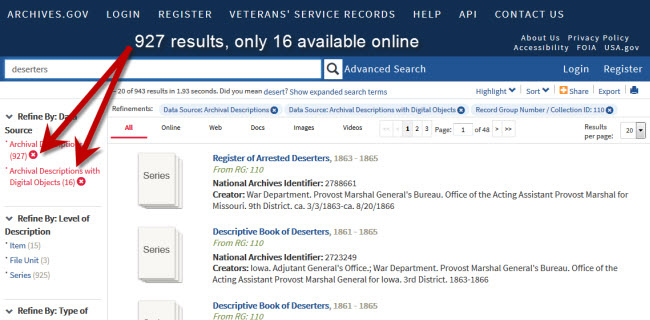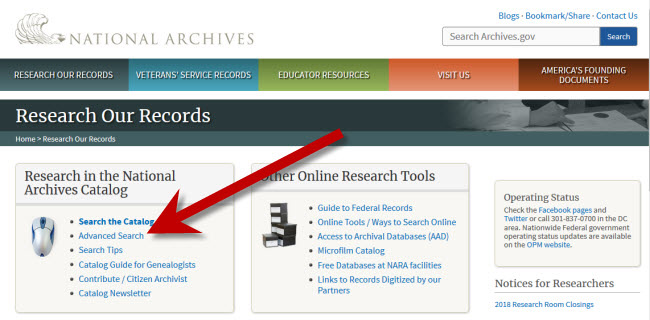NARA records gone digital
The military and related records that have been the focus of much of the discussion this week on The Legal Genealogist are, for the most part, records that you’ll find at the National Archives of the United States, or NARA for short.
Records of deserters, for example, in Record Group 110, Records of the Provost Marshal General’s Bureau (Civil War), or the records of men captured during the Civil War in Record Group 249, the Records of the Commissary General of Prisoners, are all federal records held at the main Archives I building in downtown Washington, D.C.1
Which, of course, triggered a discussion of other records that might be available — like the microfilmed records we talked about yesterday, Microfilm Publication M2156, Lists of Federal Prisoners of War Who Enlisted in the Confederate Army — and the fact that the microfilm hasn’t been digitized so you still have to go to Archives I to access it.2
So… what records of the National Archives have been digitized… and how do you know?
First off, you can always do a catalog search on the National Archives’ website, Archives.gov. From the home page, hit the link for Research Our Records in the upper left and it’ll take you to the Research Our Records landing page.
What you want is the link on the top of the page that looks like this:
Click on that link for Advanced Search and it takes you to the page where you can fill in all the options you can think of and get help as well. The top of that page looks like this:
You can enter your search term (say, deserters) and the record group (say, 110) and even get help if you need it. Doing that specific search, however, will show you that only a handful of records are available online at Archives.gov:

Sigh… That’s frustrating, isn’t it? So what can you do to find more federal records that have been digitized?
It’s easy.
You cheat, of course.
You see, over the years and continuing today, NARA has partnered with FamilySearch and Ancestry and Ancestry’s military records arm Fold3 to get more records more accessible through digitization. And there’s a cheat sheet on the NARA website of “Microfilm Publications and Original Records Digitized by Our Digitization Partners.” As explained by NARA,
Our digitization partners, Ancestry.com, Fold3.com, and Familysearch.org, have digitized selected NARA microfilm publications and original records and made them available on their web sites. … Familysearch.org is a free site. Ancestry and Fold3 are both subscription services that allow free searches of some or all index terms for each title. Free access to Ancestry.com and Fold3.com is available in all Research Rooms at the National Archives, including those in our regional archives and Presidential libraries. Agreements with our partners are such that there will eventually be free access online to all these digitized records through the National Archives Catalog.3
Now the list isn’t as up-to-date as we might like — the page says it’s updated through June of 2017 — but it’s a great starting point for finding out what is and isn’t already available somewhere online.
And note, in particular, that access to the subscription sites Ancestry.com and Fold3.com is “available in all Research Rooms at the National Archives, including those in our regional archives and Presidential libraries” — and there are a lot of those all around the country. Check out the list on the NARA website of NARA facilities to see if there’s one near you (making sure to click through to the specific location’s website to check hours, holdings and security issues before heading out to research).
SOURCES
- See Judy G. Russell, “And following up…,” The Legal Genealogist, posted 19 Apr 2018 (https://www.legalgenealogist.com/blog : accessed 20 Apr 2018). ↩
- Ibid. ↩
- “Microfilm Publications and Original Records Digitized by Our Digitization Partners,” U.S. National Archives, Archives.gov (https://www.archives.gov/ : accessed 20 Apr 2018). ↩





There is also a way to check on Ancestry.com whether a particular NARA Microfilm Publication is available there. Go to https://search.ancestry.com/search/db.aspx?dbid=1572 and either enter keywords in the “NARA Title” search field or the exact microfilm publication number in the search field for that. There is also a link at the bottom of the search page to be taken to a listing of all NARA Microfilm Publications (and collections of unmicrofilmed textual records) that are available on Ancestry.
FYI, for free access to Ancestry.com and/or Fold3, check your local public library’s online database offerings. For example my public library offers Ancestry.com at branch locations, no library card required. However Fold3 can be accessed through the library website using a library card number to login.
Also Fold3 and Ancestry are available at all Family History Centers and many public libraries – for free.
What a wonderful resource. Thanks for pointing that out.
A couple of months ago I inquired of the NARA digitization unit about that “eventually” in “there will eventually be free access online”. They pointed me to their page with links to the partner agreements (they are public records) and I saw that the current agreements with Ancestry and Family Search both include 5-year embargoes, with some complications about when that clock starts but basically from when the partner finishes a record set and makes it available under their terms. The partner has to deliver a set of images to NARA when they finish scanning, and after the 5 years is up they are eligible to made accessible free in the NARA catalog on the public Internet (once they get the catalog updated).